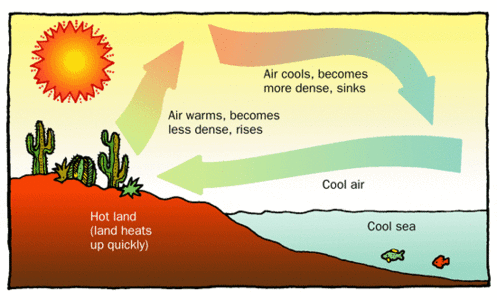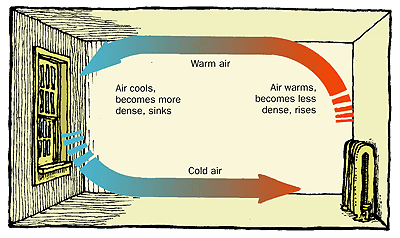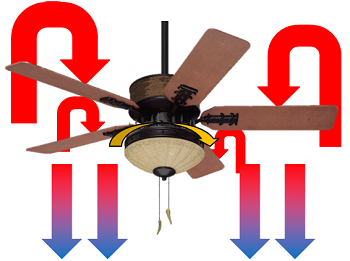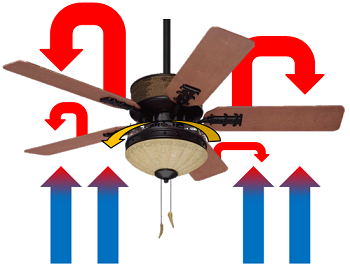Convection: Difference between revisions
m (1 revision imported: From the summer) |
m (1 revision imported) |
||
| (One intermediate revision by one other user not shown) | |||
| Line 1: | Line 1: | ||
[[Category:Done | [[Category:Done 2021-01-31]] | ||
<onlyinclude>'''Convection''' is | <onlyinclude>'''Convection''' is a way for [[heat]] to move, also referred to as a [[Heat transfer mechanisms|heat transfer mechanism]]. This transfer of [[heat]] happens when a [[fluid]] such as air or water is in motion. <onlyinclude> Convection is driven by [[temperature]] differences across that fluid. When a fluid is [[heat]]ed, the region in closest contact with the heat source becomes less [[density|dense]] due to increased [[kinetic energy]] in the particles</onlyinclude>. The portion of fluid that is less dense then rises, while the denser portion of fluid sinks. The process repeats itself because the less dense fluids cool down as they move away from their heat source, making them sink, while the denser fluids heat up as they near the heat source, making them rise. This creates convection currents. | ||
<gallery caption="Natural Convection" mode=packed heights=200px> | |||
File:Convection cell atmos labeled.gif|thumb|none|Figure 1. Air over land heats faster than air over water, leading to convection which feels like a cool ocean breeze.<ref name=Book1>”Properties of Matter Reading Selection: Density Creates Currents.” [Online]. Available: http://www.propertiesofmatter.si.edu/Density_Creates.html</ref> | |||
File: Convection cell room labeled.gif|thumb|none|Figure 2. Convection warming a room is quiet and energy efficient.<ref name=Book1/> | |||
</gallery> | |||
Convection plays a large role in wind patterns and in passive ventilation. The movement of wind across the globe is dependent on various spots where warm air rises and cool air sinks, creating large wind currents that affect weather. For example, air over land will typically get heated up by the sun during the day, while air over the sea will remain cool. The hot air over land will rise in the atmosphere. As it rises, it also cools down and becomes denser, causing it to sink once more. This concept is illustrated in Figure 1.<br /> | Convection plays a large role in wind patterns and in passive ventilation. The movement of wind across the globe is dependent on various spots where warm air rises and cool air sinks, creating large wind currents that affect weather. For example, air over land will typically get heated up by the sun during the day, while air over the sea will remain cool. The hot air over land will rise in the atmosphere. As it rises, it also cools down and becomes denser, causing it to sink once more. This concept is illustrated in Figure 1.<br /> | ||
| Line 15: | Line 16: | ||
While natural convection can be used inside houses, [[forced convection]] is more common. This is where air currents are forced through a room by a fan. Forced convection can achieve the same effects as natural convection, the process is simply aided through devices like fans. If your house has heating vents on the bottom of your walls, this is an example of forced convection. | While natural convection can be used inside houses, [[forced convection]] is more common. This is where air currents are forced through a room by a fan. Forced convection can achieve the same effects as natural convection, the process is simply aided through devices like fans. If your house has heating vents on the bottom of your walls, this is an example of forced convection. | ||
<gallery caption="Ceiling fans" mode=packed heights=250px> | |||
[[ | File:summer.png|thumb|none|Figure 3. In the summer, ceiling fans should rotate counterclockwise to mix warm air and force a cool breeze downwards, creating a downdraft.<ref name=pic/> | ||
< | File:winter.png|thumb|none|Figure 4. In the winter, ceiling fans should rotate clockwise to pull cool air up from the room and force warm air downwards, creating an updraft.<ref name=pic>''Created internally by a member of the Energy Education team''</ref> | ||
</gallery> | |||
Convection is one of the fundamental ways that heat is [[Heat transfer mechanisms|transferred]]. The others are [[thermal conduction]],<ref name=Knight>R. D. Knight, "Work," in ''Physics for Scientists and Engineers: A Strategic Approach,'' 2nd ed. San Francisco: Pearson Addison-Wesley, 2008, ch. 11, pp. 325–327</ref> [[radiant energy]]<ref name=Knight/> and [[evapotranspiration]].<ref>R. Wolfson, "High-Energy Society," in ''Energy, Environment and Climate,'' 2nd ed. New York: Norton, 2012, ch. 12, pp. 333</ref> | |||
==Further Reading== | |||
*[[Fluid]] | |||
*[[Heat]] | |||
*[[Temperature]] | |||
*[[Heat transfer mechanisms]] | |||
*Or explore a [[Special:Random|random page]] | |||
==References== | ==References== | ||
{{reflist}} | {{reflist}} | ||
[[Category:Uploaded]] | [[Category:Uploaded]] | ||
Latest revision as of 19:13, 15 October 2021
Convection is a way for heat to move, also referred to as a heat transfer mechanism. This transfer of heat happens when a fluid such as air or water is in motion. Convection is driven by temperature differences across that fluid. When a fluid is heated, the region in closest contact with the heat source becomes less dense due to increased kinetic energy in the particles. The portion of fluid that is less dense then rises, while the denser portion of fluid sinks. The process repeats itself because the less dense fluids cool down as they move away from their heat source, making them sink, while the denser fluids heat up as they near the heat source, making them rise. This creates convection currents.
- Natural Convection
Figure 1. Air over land heats faster than air over water, leading to convection which feels like a cool ocean breeze.[1]
Figure 2. Convection warming a room is quiet and energy efficient.[1]
Convection plays a large role in wind patterns and in passive ventilation. The movement of wind across the globe is dependent on various spots where warm air rises and cool air sinks, creating large wind currents that affect weather. For example, air over land will typically get heated up by the sun during the day, while air over the sea will remain cool. The hot air over land will rise in the atmosphere. As it rises, it also cools down and becomes denser, causing it to sink once more. This concept is illustrated in Figure 1.
Similar to how convection works in the atmosphere, convection also causes passive ventilation (natural air movement) in a room, as shown in Figure 2. While natural convection can be used inside houses, forced convection is more common.
Forced convection
While natural convection can be used inside houses, forced convection is more common. This is where air currents are forced through a room by a fan. Forced convection can achieve the same effects as natural convection, the process is simply aided through devices like fans. If your house has heating vents on the bottom of your walls, this is an example of forced convection.
- Ceiling fans
Figure 3. In the summer, ceiling fans should rotate counterclockwise to mix warm air and force a cool breeze downwards, creating a downdraft.[2]
Figure 4. In the winter, ceiling fans should rotate clockwise to pull cool air up from the room and force warm air downwards, creating an updraft.[2]
Convection is one of the fundamental ways that heat is transferred. The others are thermal conduction,[3] radiant energy[3] and evapotranspiration.[4]
Further Reading
- Fluid
- Heat
- Temperature
- Heat transfer mechanisms
- Or explore a random page
References
- ↑ 1.0 1.1 ”Properties of Matter Reading Selection: Density Creates Currents.” [Online]. Available: http://www.propertiesofmatter.si.edu/Density_Creates.html
- ↑ 2.0 2.1 Created internally by a member of the Energy Education team
- ↑ 3.0 3.1 R. D. Knight, "Work," in Physics for Scientists and Engineers: A Strategic Approach, 2nd ed. San Francisco: Pearson Addison-Wesley, 2008, ch. 11, pp. 325–327
- ↑ R. Wolfson, "High-Energy Society," in Energy, Environment and Climate, 2nd ed. New York: Norton, 2012, ch. 12, pp. 333





